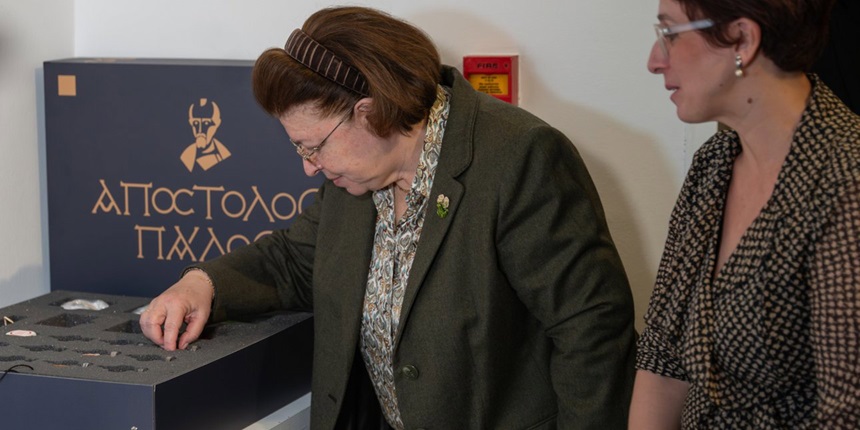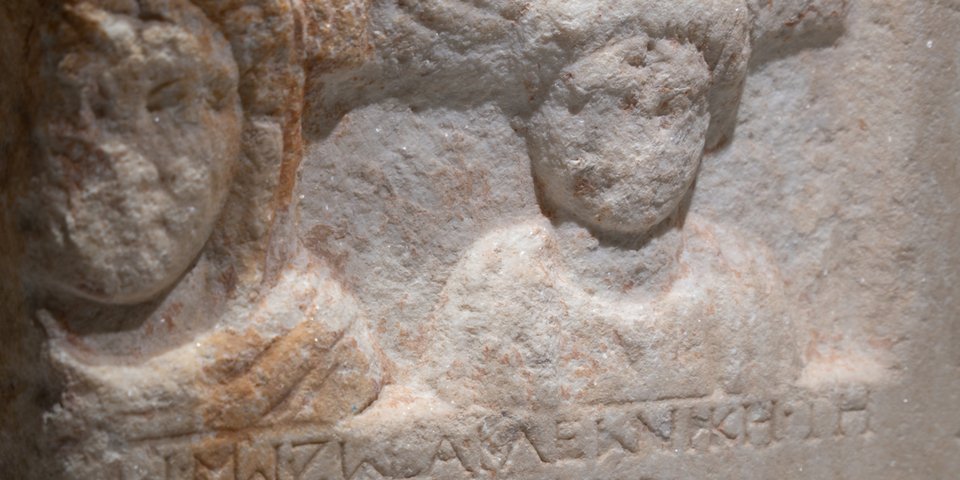Visitors to the Archaeological Museum of Thessaloniki walk… “In the Steps of the Apostle Paul”

A 300-kilometer route, the one that the Apostle Paul took on his second tour of Greece, from Samothrace and Kavala to Corinth, is now available to visitors to the Archaeological Museum of Thessaloniki, within a few square meters. This is the temporary exhibition “In the Steps of the Apostle Paul” that was inaugurated on Wednesday evening by the Minister of Culture of Greece, Ms. Lina Mendoni.
This exhibition was created as part of the Cultural Route of the same name and is being presented to the public for the first time, while after Thessaloniki, it will travel to other museums and cultural venues in Greece. “The exhibition seeks to connect religious tradition with historical testimony, including archaeological remains through and from references to the presence of Jews and the imprint left by apostolic activity in early Christian communities,” said the Minister of Culture during the inauguration, emphasising that “the exhibition presents a concise but extremely insightful and didactic overview of this apostolic route.”
The exhibition was designed by the Directorate of Prehistoric and Classical Antiquities of the Ministry of Culture and implemented within the framework of the project “Cultural Route: In the Steps of the Apostle Paul” with resources managed by the Ministry of Culture from the Recovery and Resilience Fund. “It is one of a total of five thematic cultural routes, which connect emblematic archaeological sites and monuments throughout almost the entire territory, covering all historical periods,” noted Minister Lina Mendoni, underlining that the use of the model of political routes as a tool for cultural diplomacy, management and development dates back approximately four decades, specifically “since 1987, when the Council of Europe introduced and established the institution of cultural routes with the initial aim of strengthening the common European identity and creating a unified and pluralistic cultural space, through the promotion of the tangible and intangible cultural heritage of the Old Continent. Greece was present from the beginning in the implementation of this initiative,” she said characteristically.

The museum narrative of the exhibition was structured and based on Paul’s Second Apostolic Journey to Greece, in a revised framework of documentation and reconstruction, according to the text of the Acts of the Apostles, his letters to the newly founded Christian Churches and his associates, historical and archaeological research, but also the oral tradition that preserved the Apostle’s memory unaltered. “Based on ecclesiastical texts, the main stations of the route were determined, which were Samothrace, Neapolis (present-day Kavala), the city of Philippi – where Paul baptized the first Christian, Lydia, Amphipolis, Apollonia, Thessaloniki, Veria, Pydna in Pieria – where he probably boarded a ship to travel south, Athens, Corinth and Nicopolis,” commented the head of the department of prehistoric and classical antiquities and former head of the Ephorate of Antiquities of the city of Athens, Ms. Elena Kountouri. She also emphasised that the working group that was formed conducted scientific investigations at all these sites, archaeologically documenting the Second Apostolic Journey for the first time, and in fact, “monuments that can be connected to Paul’s journey were discovered and marked for the first time, such as the early Christian Basilica in Paleopolis of Samothrace and the gates of the walls of Amphipolis.”
The experience of the cultural route is completed with this specific periodic exhibition, which captures the apostolic route with rich visual material, presenting many of the monuments, landscapes and objects that can be connected to it. The exhibition is enriched with objects from the collections of the Archaeological Museum of Thessaloniki, which illuminate aspects of the society of Thessaloniki in the period before and after the passage of the Apostle Paul and echoes the impact of his teaching. “Our museum completes its contribution to this important periodic exhibition of the cultural route, which aims – like any cultural route based on a specific narrative – to communicate historical messages and satisfy one of the basic needs of today’s travellers, that of the experiential experience of the cultural and historical reserve of our country”, pointed out the general director of the Archaeological Museum of Thessaloniki, Ms. Anastasia Gadolou.

In parallel with the exhibition, a museum kit is available to the children, where the Apostolic Tour and the world of Paul come to life through educational games and activities. The exhibition will remain at the Archaeological Museum of Thessaloniki until the end of April, while it will also tour other exhibition spaces located near the stops of the second apostolic tour, such as Athens, Corinth, Nikopolis, Pieria, Veria, Amphipolis and Alexandroupoli.




